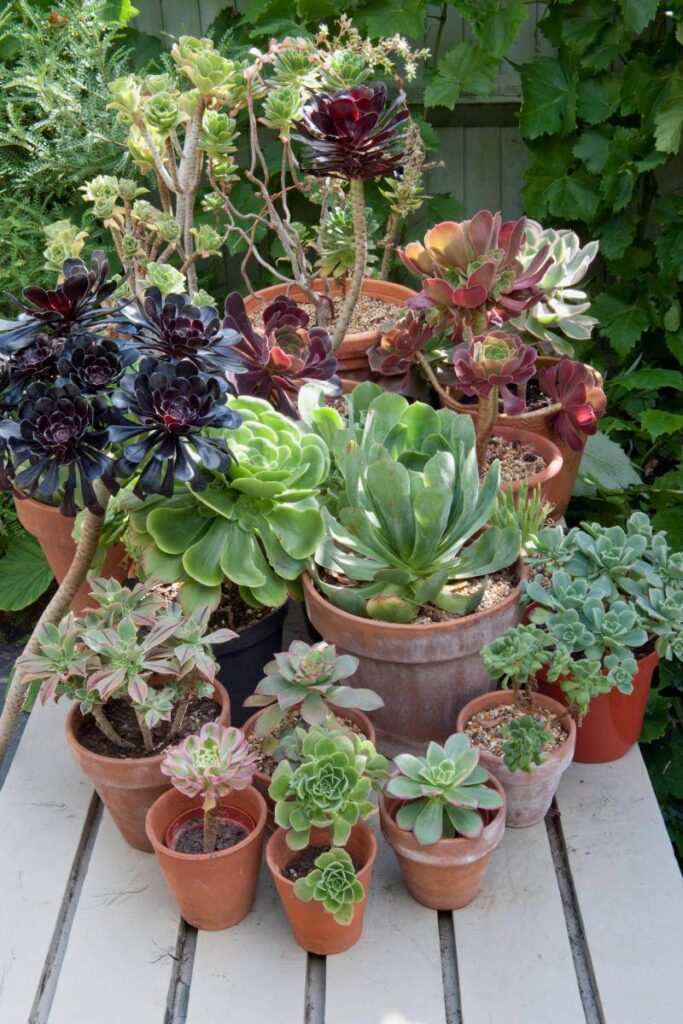Whether in bowls, troughs or even picture frames, succulents can add a touch of the tropical to any garden, in a display of multicoloured rosettes or in a dry bed among cacti and other drought-loving favourites.
View this post on Instagram
“A great feature is the indoor outdoor nature of the plant – it can be a house plant, but it can also be a patio plant, so your imagination can run wild,” enthuses gardening influencer Michael Perry, aka Mr Plant Geek.
So, how best can we display succulents?
Create a ‘xeriscape’ filled with drought-tolerant plants
View this post on Instagram
“Xeriscaping is growing without the use of water – and succulents such as sedum pair super nicely with things such as verbena, which have a totally different look to them,” says Mr Perry.
This might involve creating a gravel garden or scree bed, adding drought-tolerant plants to achieve your goals. “Xeriscapes are the perfect home for succulents such as semponiums,” he advises.
Read: How to pick the best containers for your garden
Make full use of succulents’ colour

The rosettes of houseleeks (sempervivum) vary from deep plum colours to acid green, pink and cream, but none shines as brightly as the ‘Chick Charms Gold Nugget’, which produces rosettes of waxy, bright yellow leaves tipped with red, changing to bright green in the summer before reverting to their fiery colour in the winter. Plant them in free-draining soil in full sun and protect them from winter wet and you shouldn’t go far wrong.
Some succulents are super hardy in really free-draining soils or in gravel gardens. These include the Sedum ‘Sunsparkler’ series (Thompson & Morgan; thompson-morgan.com), showy little stonecrops with terrific leaf colour, neat growth habit and showy flowerheads. They are low-growing, so make colourful ground cover in alpine gardens and rockeries or in troughs and containers.
Carefully choose the right pots for your succulents

“The pot needs to fit in with its surroundings,” advises Sam Everiss, horticulturist at RHS Garden Hyde Hall. “It depends on the type of property you have.”
Another factor is the size of the plant and she says: “Sempervivums and echeverias would pair well in a shallow pot, whereas aeoniums would need a bigger pot because they are a bigger plant. Even some small aloes would go in a shallow pan.” Pack them close together for a quick, impressive display.
Read: Indoor plants can have some surprising health benefits
Pair succulents to create striking effects

“The Aeonium ‘Schwarzkopf’ makes a good pairing with a tender bedding plant such as Dichondra ‘Silver Falls’. You can also use kalanchoe (outside in summer) and Pelargonium sidoides as a trailer,” says Ms Everiss. “I like to group aeoniums together in contrasting colours, but keep them in separate pots because they have different growth habits.”
Mr Perry adds: “Containers offer a nice showcase for the plants – pair semponium with dramatic silver of Senecio ‘Angel Wings or the fun filler calocephalus.”
Get creative with where you plant succulents – and try a picture frame

Try planting shallow-rooted succulents in a frame to attach to an outside wall, or even in a wreath on the front door. Mix different coloured varieties of the same type of succulent into a shallow bowl to make a chequered arrangement for a table centrepiece, find unusual recycled receptacles in which to display particular species, or refurbish an old wooden ladder on which to show individual pots of your favourites.
Select the right growing medium for your succulents
“I’ve found that what works well for us is Melcourt peat-free compost which is very lightweight – 50 per cent wood chip, 50 per cent coir, mixed with perlite. You want a really free-draining soil,” says Ms Everiss.
Look after your succulents once summer is over
View this post on Instagram
Succulents have varying needs in wintertime. Ms Everiss says: “We have shallow troughs full of sempervivums and sedums, which have lasted through the winters for around five years, but they need to be sheltered from rain because they don’t like winter wet.
“But different succulents have different watering requirements. Look at the plant: Is it going yellow because it’s getting too much water? Is it losing its leaves? Some succulents need more water than others.”
Read: How to make your small garden feel bigger
She adds: “Aeoniums are happy to be indoors over winter and can then come out in the summer.”
Meanwhile, aloe aristate (lace aloe) – a low-growing evergreen perennial that looks brilliant on a sunny, sheltered patio and forms rosettes of fleshy lance-shaped leaves with white spots – will need to be moved indoors to a conservatory or windowsill after summer, she says.
View this post on Instagram
The more tender succulents that need to be brought inside should be placed somewhere with lots of light. Water them once a month if you need to, but maybe leave them longer, Ms Everiss advises.
Do you have succulents in your garden? Let us know in the comments section below.
– With PA

